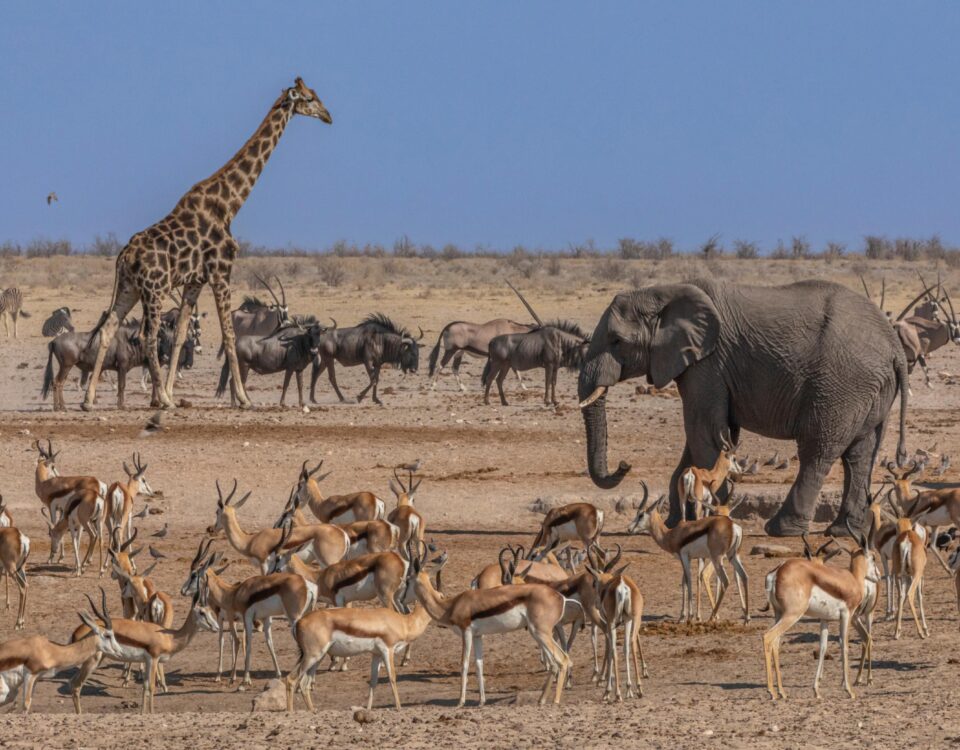
Eventful days at the Linyanti
January 9, 2019
Game Guards trained to Prevent Poaching
January 9, 2019I accidentally stumbled upon the Rhodesian Ridgeback 15 years ago when I was living in Windhoek. My neighbour often visited with her lustrous red hound with its fantastic character and charming intelligence. I was sold on him, mostly by his character and gentle nature, but also because of the smell of his protective presence that lingered in my house.
Years later, when my husband and I moved to the farm permanently, our ideal picture wasn’t complete without the red dog at our side. Needless to say, we bought our first Rhodesian Ridgeback female. We named her Shiza, which is Swahili and means “she who walks like a lion”. She became our constant companion, and, as many childless couples do, was reared as the child in our house. Merely by chance, we became aware that she had an incredible natural instinct whenever someone was on the track of a wounded animal.
The first time this became apparent to us, the novice dog handlers, was when one of our hunting clients, unfortunately, wounded a springbok. It was mid-March and we felt the humid heat even bounce off from the grass. We followed the track for quite some time, with all signs indicating that it was a gut shot. The springbok was running with a herd of more than 150 animals and we knew that the day would get longer and warmer as we continued on the track. Shiza was happily trotting along paying off, but she kept darting from one shady spot to the next, which caused me to make some embarrassing excuses to the client, and I kept a close watch on Shiza.
At some stage, I lost sight of her. I turned around to see if she was behind me waiting in the cool shade of a shepherd’s tree again, but she was gone. One of my trackers directed my eye forward, to where the herd of springbok was scurrying away from us. At that very moment, the back of the herd started to run at full speed, and that was when I noticed the agile red dog at their heels. I stared in awe and watched the first of many such pursuits. She was weaving her way through the herd of springbok, faster and faster, with long leaps that made her hind legs almost touch her ears, but without a sound or grabbing at any of the springbok. And then, right in the middle of the herd, as if in slow motion, she reached towards one ram, snapped at his ankles, and down he went with a cloud of dust gathering around the action. And there she was, baying him, without taking notice of all the others that rushed past them at full speed, all the while barking and barking.
The Rhodesian Ridgeback is one of only two registered breeds indigenous to Southern Africa. Its ancestors can be traced to the former Cape Colony in South Africa where they were crossbred with the early pioneers’ dogs and the semi-domesticated dogs of the indigenous people. The Boers used many of the breeds they brought with them to crossbreed with the Khoi dogs, or Hottentot Hunting Dogs, as they required a dog that was resistant to local diseases and more suitable to frontier life.
In 1879 Reverend Charles Daniel Helm brought two dogs from Kimberley to his mission station near Bulawayo in south-western Zimbabwe. These two bitches are regarded as the origin of the breed that became known as the Rhodesian Ridgeback.
A hunter by the name of Cornelius van Rooyen, who operated mainly in Matabeleland, mated these two rough-coated, grey-black dogs with his pack and the famous ridge on the dogs’ back emerged.
Cornelius van Rooyen crossed several breeds with the Hottentot Hunting Dog: the Bloodhound/Pointer (for a good nose), the Greyhound (for speed), the Bulldog/ Bullterrier (for courage and tenacity), the Airedale and Irish Terrier (for dash and spirit) and certainly the elegant Deerhound and Staghound (for stamina). The dog’s usefulness far outweighed its looks or adherence to any particular type, but it was noticed that the ridge of the Hottentot dog manifested itself in many of the offspring from mating local with European dogs. As a dominant gene, it recurred generation by generation.
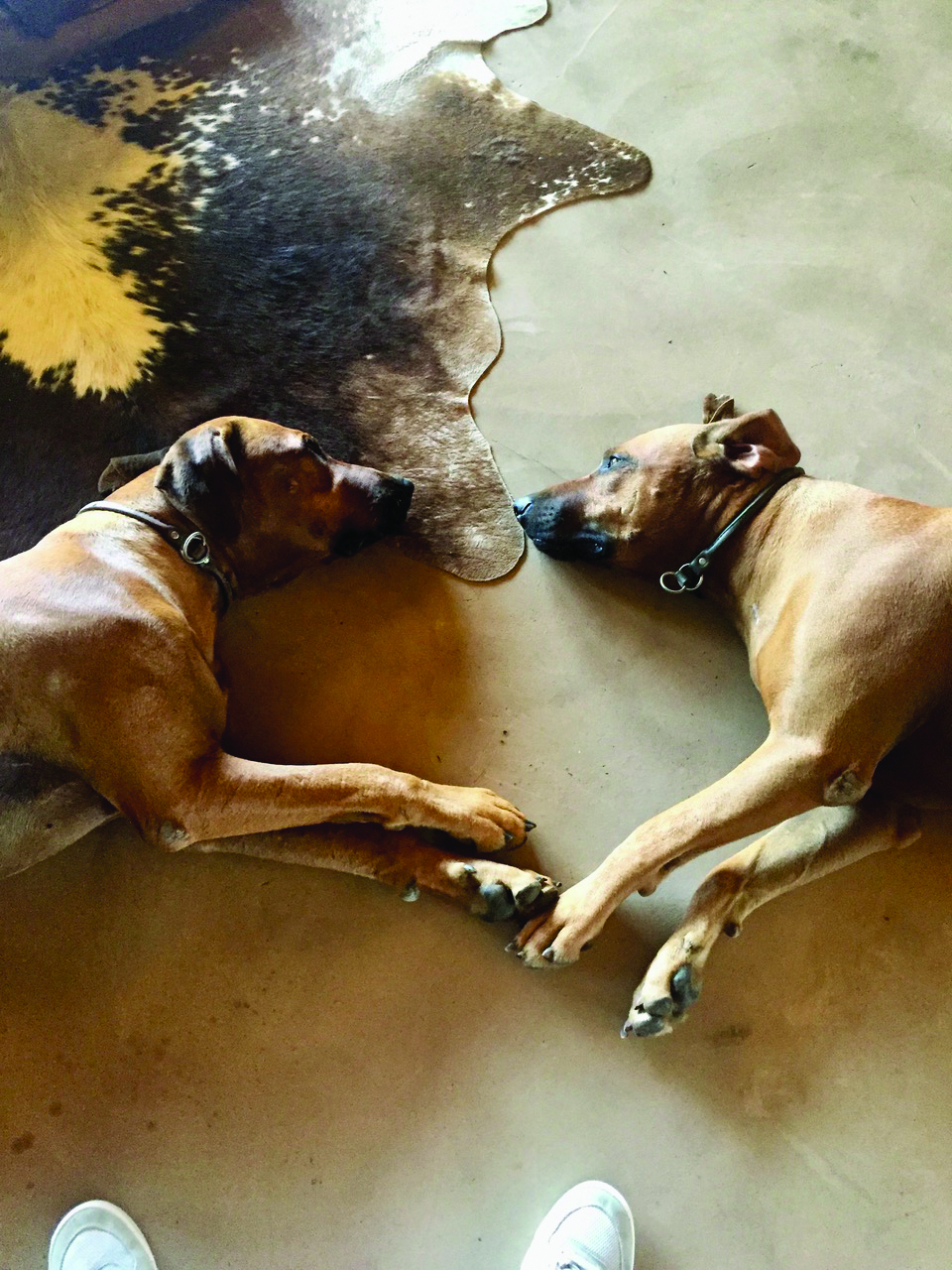
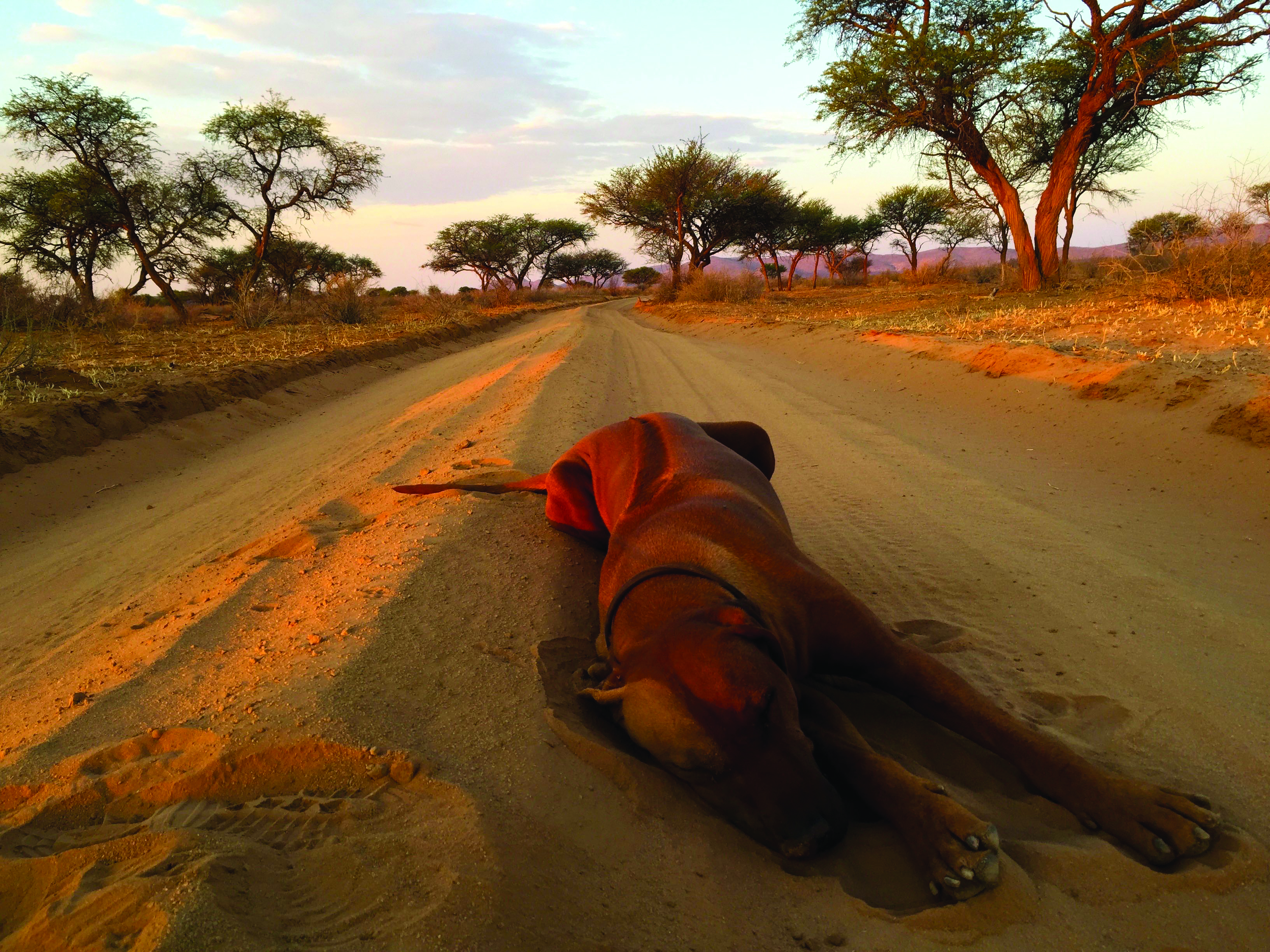
These lion hounds would hunt ordinary game silently, picking up the scent and following it until the quarry came into sight. When the hunter caught up, the stalk would begin. Hunting mainly in groups of two or three, it was a case of attack, feint, dodge, worry, snap and retreat, but above all confine the beast, allowing the hunter to get into position for a good, clean shot. Only the very fittest and most skilful dogs lived to pass on their qualities to the next generation.
The most common misconception about Rhodesian Ridgebacks is that they actually kill lions. Nothing could be further from the truth. No dog, no matter how courageous, can kill a lion.
To obtain a better understanding of these magnificent animals, it is first necessary to appreciate their multi-faceted nature, their flexibility and adaptability, their excessively affectionate and sensitive disposition, their highly developed intelligence, but, most importantly, their firm adherence to pack law. The latter characteristic results in bonding very strongly with the pack as a whole to ensure mutual survival. They are prepared to sacrifice their lives in defence of the pack. When placed in the company of us humans (when living with us) they will bond with us and, having done so, behave in accordance with their nature which entails defending the family unit or pack, to the fullest extent of their abilities.
Having bonded with you (and one cannot over-emphasise the tremendous importance of this bonding experience in how they will evaluate their position), you have gained the friendship and affection of a truly loyal companion for the duration of his or her life. It is a relationship which is fully experienced by the human as well and it is probably this quality alone why all of us who have successfully bonded with these fine, brown-coloured, everlasting friends hold the Rhodesian Ridgeback in awe and respect.
My friends multiplied over the years. Tau, meaning “lion”, was our next Rhodesian Ridgeback, and we had four litters come from Shiza and Tau. We kept one male from the first litter and named him Kondo, which means “war” in Swahili. Two years ago, we bought another female from a different breeding line and called her Hatari which means “danger”.
It is one of my greatest joys each year, when we visit Swakopmund on the Namibian coast during our December break, to take my Ridgebacks for a run every morning. Having mentioned the very strict discipline and bonding methods which I enforced diligently, my Ridgebacks are able to run alongside me for more than 10 km every morning, enjoying the fresh sea breeze, without as much as a collar or leash. Older ladies will quickly gather their much-loved miniature Poodles and Jack Russels into their arms merely at the sight of me with four enormous looking red beasts coming their way while waving an admonishing finger at me and demanding a leash on the big hounds. Yet every time it fills me with extreme gratification to have these pack dogs run alongside me without a wrong movement or even the slightest sign of contemplating a breakaway to go after the yapping sounds. They stop at any red light and follow again obediently as soon as I softly say kom (come).
On a few occasions, while out on a run on the farm, the two males would all of a sudden run a little distance ahead of me, and even though I would strictly demand their return in a huff-puff voice, they would continue for about 200 meters, stop, and block my way. That was when there were cheetahs slowly jogging ahead of us, every now and then turning their gaze towards us. The dogs wouldn’t give chase, they would only stop me in my tracks until it was safe to give the go-ahead.
Their character and temperament are dignified and they have an independent mind – they can evaluate a situation and act accordingly without instructions. Though naturally obedient and easily trained, you will never get that instant submission you see in working breeds. Ridgebacks are partners… not servants! They have a sense of humour, are aloof and stand-offish with strangers, but show no aggression or shyness. A Ridgeback is a creature of grace and dignity, loyal to the end.
The behaviour of the Rhodesian Ridgeback towards children is legendary. They, the children, are the weakest members of the pack and must be defended with particular vigour. Rhodesian Ridgebacks are very conscious of those “soft” targets and make a greater effort to protect them.
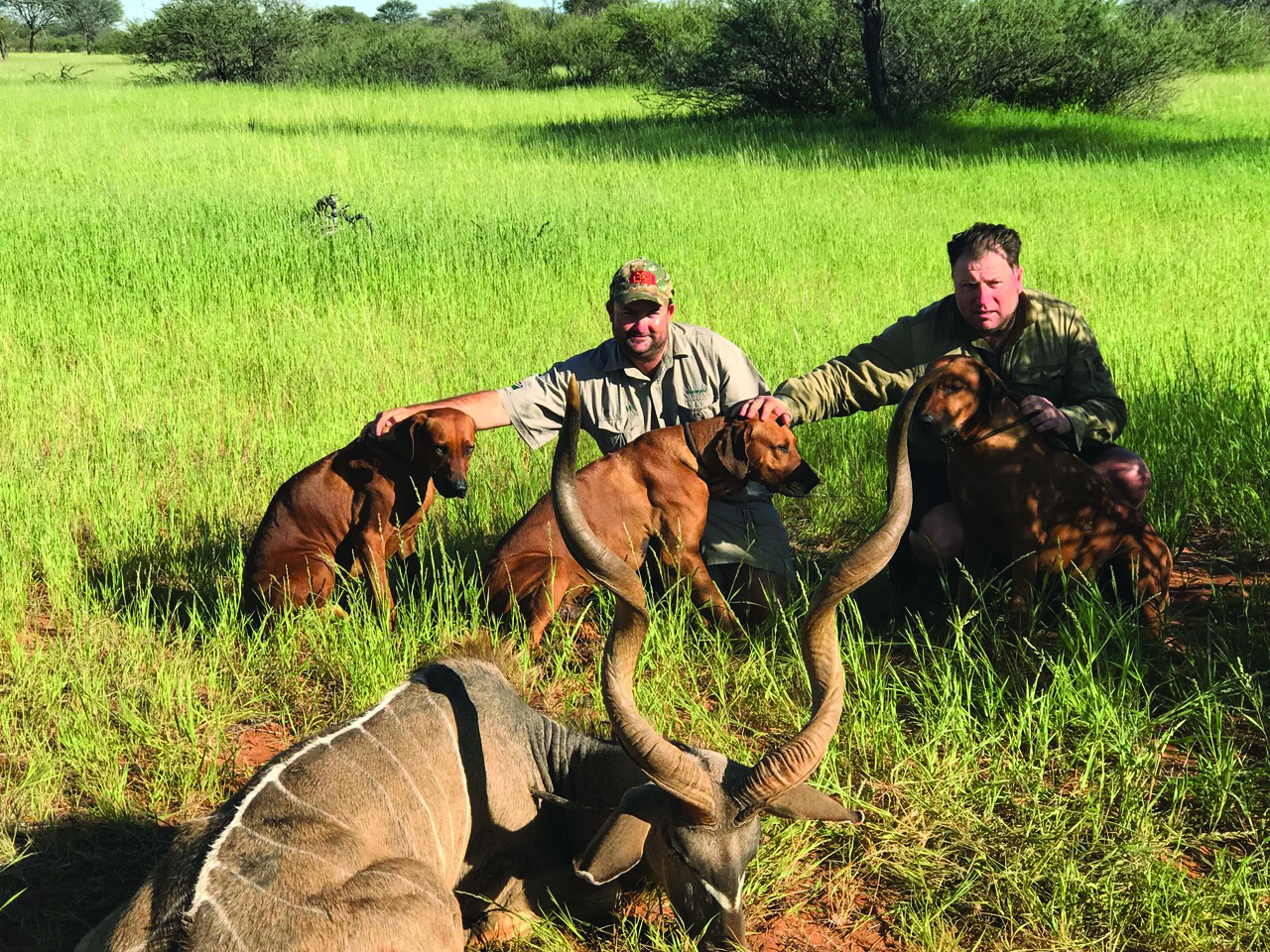
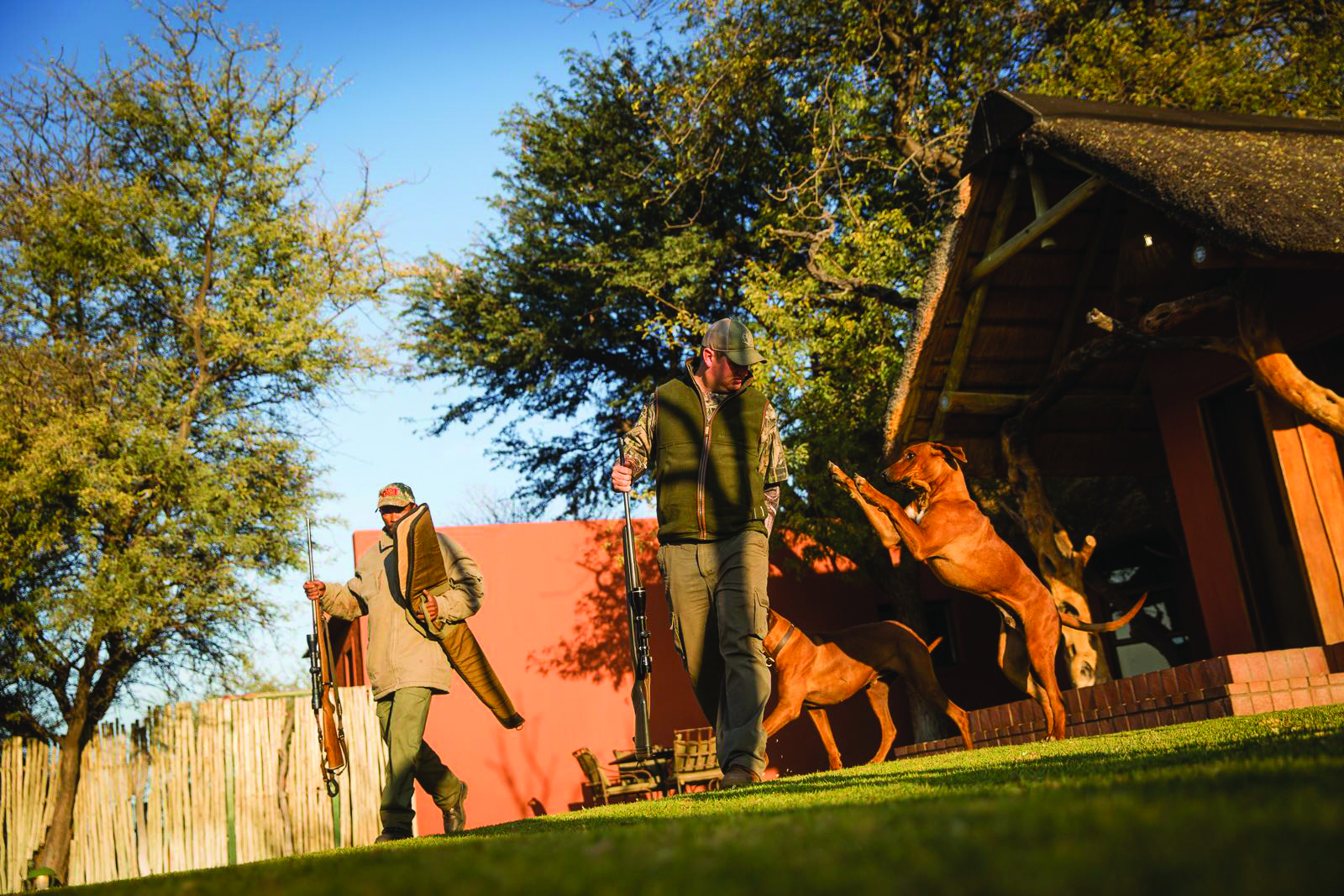
If they must take action they will be most gentle with the child (they have an emotional appreciation of the young and adjust their responses accordingly). If need be they will retreat from the child’s path, usually after a gruff bark.
Our three beautiful children grew up with Rhodesian Ridgebacks. To me, the most impressive and spectacular trait every single one of our Ridgebacks has shown is the extreme patience they have had with each of the children and their beautifully soft mouths. Tails were pulled, open wounds were explored by tiny fingers and ears were bitten many a time, believe me. But at the most, our dogs, when at the very end of their patience would just get up and leave.
Another event I remember very vividly was when Tau was recuperating at my parents’ house from another stitch-up operation at the veterinary in Windhoek after a gemsbok rammed its horn into his side. Every day for about two hours he would disappear from my parents’ yard, nowhere to be found. We were puzzled about his whereabouts, even more so because the area was electrically fenced. After a few days, one of their neighbours came to ask whether we owned a red dog. “Yes”, replied my mother, “but he disappears every afternoon and majestically reappears after a while.” The lady informed my mother that every afternoon this dog would come into their house and, as if it were his own, move straight into the room of her ailing husband, dying of cancer, and lie at his feet.
I can recall many other snippets and stories of this impressive dog, but the most significant to me is that the Rhodesian Ridgeback has proven to be a most formidable hunter.
They were carefully and specifically crossbred with well-known breeds of dogs to perform a specific function, which was to hold a lion at bay. Baying entails distracting the “object” in such a way that it remains in that one spot for as long as it takes to complete the exercise, which usually meant that someone would shoot at the “object” from extremely close-up, with the very ineffective rifles of those times. Hence the need for keeping the “object” at bay.
The Rhodesian Ridgeback is equipped with enough power to cope with most bush-related situations. One should never forget, however, that he was bred to BAY lions, not bite or kill them, which in any event is a ludicrous notion at the best of times. This dog is equipped with great intelligence and physical power. Add to that his extreme sensitivity to the mental posture of others which gives him the advantage to assess the intentions of his adversary well before such adversary has had a chance to move. When overfaced he must use his considerable physical attributes to escape, but this, of course, hinges on his pack loyalties and responsibilities at the given time. His success at baying, and escaping, depends upon his strength, his manoeuvrability, his feinting tactics, but more importantly upon his ability to make the correct survival decisions. He has a strong forechest because that is his primary strike weapon. I have observed very robust tactics while at play and how a dog can very audibly crash into the other.


There are stories that he can hit a kudu with sufficient force to cause it to stumble and provide him with an opportunity to obtain a good throat-hold.
I have personally witnessed how a large zebra delivered a massive blow with both hind legs into the chest of Tau, which threw him back a good few meters, but as soon as his feet touched firm ground he leapt back, attempting a successful bay at another angle.
I was lucky enough to have one specific hunt on film, where two of my dogs followed the blood trail of a wounded roan. That evening the cameraman showed us a slow-motion version of the pursuit and bay. The specific shot was a bad call on my part. It was too late in the day, too far for a shot, at too bad of an angle. My hunter was experienced but I was impatient. While the sun was setting behind the mountain, both my hunter and I watched the roan look at us, its ears broadly stretched, flicking away some flies, waiting for us to call it a day. I told my client to take the shot. The thunder of the bullet still rings in my ears, as if to remind me of the virtue of patience. We both saw a slight reaction in the roan, but off it went, at a determined speed. We quickly went to the spot where it last stood, while both dogs’ muscles tinged and stressed, waiting for my command to follow up. After inspection, we noticed traces of blood and stomach content. I was angry with myself, but with no light to spare I gave the command to the dogs to go. Only minutes after their lightning take-off, we could hear them barking. We started running towards the sound, and there they stood, less than 800 metres away. A magnificent roan, fighting off the red flashes signalling the end of its life. I put the hunter on the sticks again at about 60 metres away, called off the dogs and told him to shoot. But within that endless second, the roan slipped away and ran off into the sun. I cannot recall visually what happened after that, as only a few seconds passed. I know the dogs chased after the roan again, bayed it again, and the hunter made a calculated shot which brought the animal down immediately. It was only afterwards, in the evening, that I could fully appreciate and realise the work which both dogs had done that day with determination and incredible technique, and for that matter every time they went after the quarry. In slow motion we could see the red line of speed haring from the bottom left corner of the camera lens, making ground towards the roan, delivering an ankle-tap to one of the hind legs of the roan, and while it was falling to the ground, one dog slipped through underneath its buckling legs and stopped right in front of it, ready to bay from the front, while the other one guarded the flank.
A Ridgeback will give you ample warning of any dangers in close proximity and is unequalled when tracking down wounded animals. He is so efficient in the latter that some hunters believe he can “feel” where the injured animal is: he often tracks far from the original spoor.
All our dogs are so-called specialists in their field, and each of them has a unique trait when tracking. None of them was trained by us. They all work according to their own natural instinct.
After an extremely difficult kudu hunt, where we walked numerous mountains in pursuit of a kudu bull for many days, another goose-bump story unfolded in front of our eyes. A seemingly good shot was taken at a thick-necked kudu bull very high up on a mountain. We followed its tracks and after some time one of our trackers spotted the bull ahead of us. Without having set eyes on it and scared that we might frighten it off into a run, we approached ever so slowly, swallowing each breath, trying to reach an opening where we could set up the sticks. When we finally came into a clearing, our thighs cringing with cramps, we desperately tried to spot the kudu. Minutes went by as all of us overexerted our eyes, with quick intervals of cleaning our binocular lenses fogged up with sweat. And then I saw them, two mountains away already. We could do nothing but sit and watch. In all of the few, but also very long minutes that passed, the kudu, as well as the dog outsmarted us. We watched as the dog ran a good 200 meters below the kudu, under the wind without even having sight of it, by simply following the scent, leading up to it in an arch, and finally keeping it at bay. It took us two hours to reach them, with the dog never even thinking of abandoning its task.
Yes, the lion is probably the world’s most efficient predator.
But Rhodesian Ridgebacks have tremendous respect, bordering on fear, for the big cats. And quite rightly so. A Ridgeback, physically, represents no threat whatsoever to a lion. Furthermore, it would be very little effort for a lion to finish off this dog. And the Ridgeback is fully aware of this state of affairs. But the lion also knows that the Ridgeback can overcome his fear and proceed to goad and terrorise him. In spite of his physical inferiority, the Ridgeback represents a very real psychological threat to the lion. And so “the game is on” and one of nature’s potentially most unequal contests takes place successfully as a result of the intelligence and cunning, and the speed and power of the dog.
Fortunately, the rifles of today to some extent preclude the need for the hunter to close in on a lion to within 30 metres purely because of the inadequacy of his weaponry. The Ridgeback, however, has many other qualities which guarantee him a place in all bush activities on a daily basis. It is out there, running freely in the veld, that you can witness his specialist skills in dealing with every problem the bush can throw at him. That is where he was designed to operate and that is where he reigns supreme. The African hunter’s companion, my soulmate.
A special thanks to Scotty Stewart who provided me with me with information on the history of Ridgebacks. Visit the website: www.rhodesianridgeback.org.za
This article was first published in HuntiNamibia 2018.


